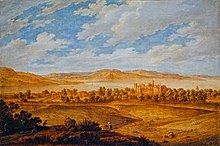
Seton Palace was situated in East Lothian, a few miles south-east of Edinburgh near the town of Prestonpans. Often regarded as the most desirable Scottish residence of the sixteenth and seventeenth centuries, the palace was erected in the 15th century by George, 4th Lord Seton.[1]
The palace belonged to the Lords Seton by the 1500s and was a popular retreat for Mary, Queen of Scots. She had spent her honeymoon with Lord Darnley there in July 1565.[2] Mary played golf at Seton, and it was said she played "pall-mall and golf" as usual in the fields at Seton after Darnley's murder,[3] "Pall-mall" was an early form of croquet.[4] A marriage contract of Mary and Earl of Bothwell made at Seton on 5 April 1567 and exhibited by Mary's enemies at the Hampton Court conference on 15 December 1568,[5] was probably a contemporary forgery and the actual contract was made in Edinburgh on 14 May.[6][7][8]
In the 17th-century, the completed palace was triangular in plan, with three wings around a courtyard.[9] In 1636, it was described as "a dainty seat placed by sea".[10] The palace ruins were demolished in the 18th-century and Seton Castle was built on the site. The adjacent Seton family chapel, Seton Collegiate Church, survives and is open to the public in the care of Historic Environment Scotland.
- ^ Seton Castle, Castles of Scotland
- ^ David Laing, History of the Reformation by John Knox, vol. 2 (Edinburgh, 1848), p. 492: Calendar State Papers Scotland, vol. 2 (Edinburgh, 1900), p. 181: Joseph Stevenson, Selections (Glasgow, 1837), pp. 119, 141.
- ^ Gordon Donaldson, The first trial of Mary, Queen of Scots (New York: Stein and Day, 1969), 177.
- ^ James Aikman, History of Scotland of George Buchanan, vol. 2 (Glasgow, 1827), pp. 497-8: Joseph Bain, Calendar State Papers Scotland: 1563-1603, vol. 2 (Edinburgh, 1900), p. 558: John Hosack, Mary Queen of Scots and her accusers, vol. 1 (Edinburgh, 1870), p. 542, the original has "palmall and goif."
- ^ Antonia Fraser, Mary Queen of Scots (London: Phoenix Press, 2002), p. 504: Agnes Strickland, Letters of Mary, Queen of Scots, vol. 1 (London, 1842), p. 104.
- ^ John Guy, My Heart is My Own: Mary, Queen of Scots (London, 2004), p. 400: A number of old copies of this contract exist; HMC 6th Report: Leconfield (London, 1877), p. 306: HMC 5th Report: Duke of Sutherland (London, 1876), p. 213.
- ^ John Hosack, Mary Queen of Scotland and her Accusers, 1 (Edinburgh, 1869), pp. 555–557.
- ^ British Library Add MS 48027 f.277, copy of the Seton marriage contract
- ^ Charles McKean, Scottish Chateau (Stroud, 2001), p. 175.
- ^ P. Hume Brown, Early Travellers in Scotland (Edinburgh, 1978), p. 136.